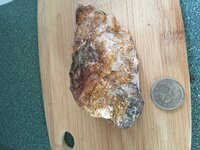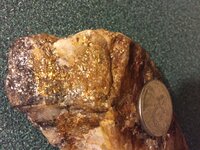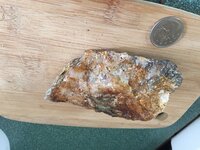Navigation
Install the app
How to install the app on iOS
Follow along with the video below to see how to install our site as a web app on your home screen.
Note: This feature may not be available in some browsers.
More options
You are using an out of date browser. It may not display this or other websites correctly.
You should upgrade or use an alternative browser.
You should upgrade or use an alternative browser.
Opinions for a newbie - gold/pyrite/copper/iron
- Thread starter ck-gold
- Start date
-
- Tags
- gold hardrock mining
- May 28, 2010
- 19,732
- 31,020
- 🥇 Banner finds
- 1
- 🏆 Honorable Mentions:
- 1
- Detector(s) used
- Nokta Makro Legend// Pulsedive// Minelab GPZ 7000// Vanquish 540// Minelab Pro Find 35// Dune Kraken Sandscoop// Grave Digger Tools Tombstone shovel & Sidekick digger// Bunk's Hermit Pick
- Primary Interest:
- Metal Detecting
Yeah, I have a thought. Why haven't you just done a scratch test? A jeweler would do it for free. Now I think I'll have some ice cream. Best of luck!

kcm
Gold Member
What else can you tell us about the sample? Area from? near surface or from inside a mine? From an abandoned mine? Was it found at the source or would this be float?
It's beautiful mineralization and maybe some of the experienced folks can tell you something without any more info, but all the info you can provide will help EVERYONE greatly.
...And welcome to Tnet!
It's beautiful mineralization and maybe some of the experienced folks can tell you something without any more info, but all the info you can provide will help EVERYONE greatly.
...And welcome to Tnet!

- May 28, 2010
- 19,732
- 31,020
- 🥇 Banner finds
- 1
- 🏆 Honorable Mentions:
- 1
- Detector(s) used
- Nokta Makro Legend// Pulsedive// Minelab GPZ 7000// Vanquish 540// Minelab Pro Find 35// Dune Kraken Sandscoop// Grave Digger Tools Tombstone shovel & Sidekick digger// Bunk's Hermit Pick
- Primary Interest:
- Metal Detecting
What did the jeweler say? A "Scratch test" involves testing the scratch with acid to determine karat.
Mad Machinist
Silver Member
I have some samples I soaked in muriatic acid for a few days- it's got all the good colours and some very obvious mineralization. Is the golden colour I'm seeing mainly pyrite? I'm waiting to crush it until my partner is present. Any thoughts?View attachment 1335616View attachment 1335617View attachment 1335618
And you are planning to do what with it

 ?
?You do understand that iron pyrite is a sulphide based mineral right? In order to process sulphide ores they need to be roasted and they give off Sulphur Dioxide, it has a rotten egg smell.
Sulphur Dioxide will kill your sense off smell if you are exposed to it for too long so you might think it went away. It will build up in the air, if in an enclosed area, and it quite effectively send you to the gold mine in the sky.
Mad Machinist
Silver Member
So I've been doing some research on this problem of processing sulphide based ores. Based on the research I have read, a 1" layer of activated charcoal made from palm based feedstock will remove approximately 80% of the sulfur dioxide from the air along with a lot of other nasty stuff like arsenic trioxide.
It appears at this time a "diy air scrubber" with multiple layers of palm based activated charcoal will effectively reduce the poisonous and troublesome off gases to well below acceptable levels for daily tolerances and pollution levels.
Enjoy.
It appears at this time a "diy air scrubber" with multiple layers of palm based activated charcoal will effectively reduce the poisonous and troublesome off gases to well below acceptable levels for daily tolerances and pollution levels.
Enjoy.
kcm
Gold Member
That's interesting - hadn't heard that. I wonder how other sources of activated charcoal compare?
Mad Machinist
Silver Member
That's interesting - hadn't heard that. I wonder how other sources of activated charcoal compare?
I think we would be better off with a wet scrubber. Less cost in the long run and easier to set up. This is important enough to have it's own thread, hence the other thread.
Eu_citzen
Gold Member
- Sep 19, 2006
- 6,484
- 2,111
- Detector(s) used
- White's V3, Minelab Explorer II & XP Deus.
- Primary Interest:
- Prospecting
Interesting.... Reminds me of my old days when I tried jewellery making.So I've been doing some research on this problem of processing sulphide based ores. Based on the research I have read, a 1" layer of activated charcoal made from palm based feedstock will remove approximately 80% of the sulfur dioxide from the air along with a lot of other nasty stuff like arsenic trioxide.
It appears at this time a "diy air scrubber" with multiple layers of palm based activated charcoal will effectively reduce the poisonous and troublesome off gases to well below acceptable levels for daily tolerances and pollution levels.
Enjoy.
Back then we used what we in swedish called "vinsyra" as a flux, albeit rarely.
Tartaric acid as its known in english, forms coal when heated and produces (I assume) a reducing atmosphere.
hvacker
Bronze Member
I went to a mine here in NM a couple years ago known mostly for it's malachite.
There had been a lot of burning off sulfides but what I found interesting was the
smell was still very strong after mining had stopped 60 years ago.
There had been a lot of burning off sulfides but what I found interesting was the
smell was still very strong after mining had stopped 60 years ago.
Top Member Reactions
-
 3481
3481 -
 1989
1989 -
 1911
1911 -
 1160
1160 -
 1090
1090 -
 1009
1009 -
 888
888 -
 863
863 -
 859
859 -
 796
796 -
 761
761 -
 676
676 -
 659
659 -
 567
567 -
 508
508 -
 450
450 -
 446
446 -
 410
410 -
 401
401 -
E
398
Users who are viewing this thread
Total: 2 (members: 0, guests: 2)







